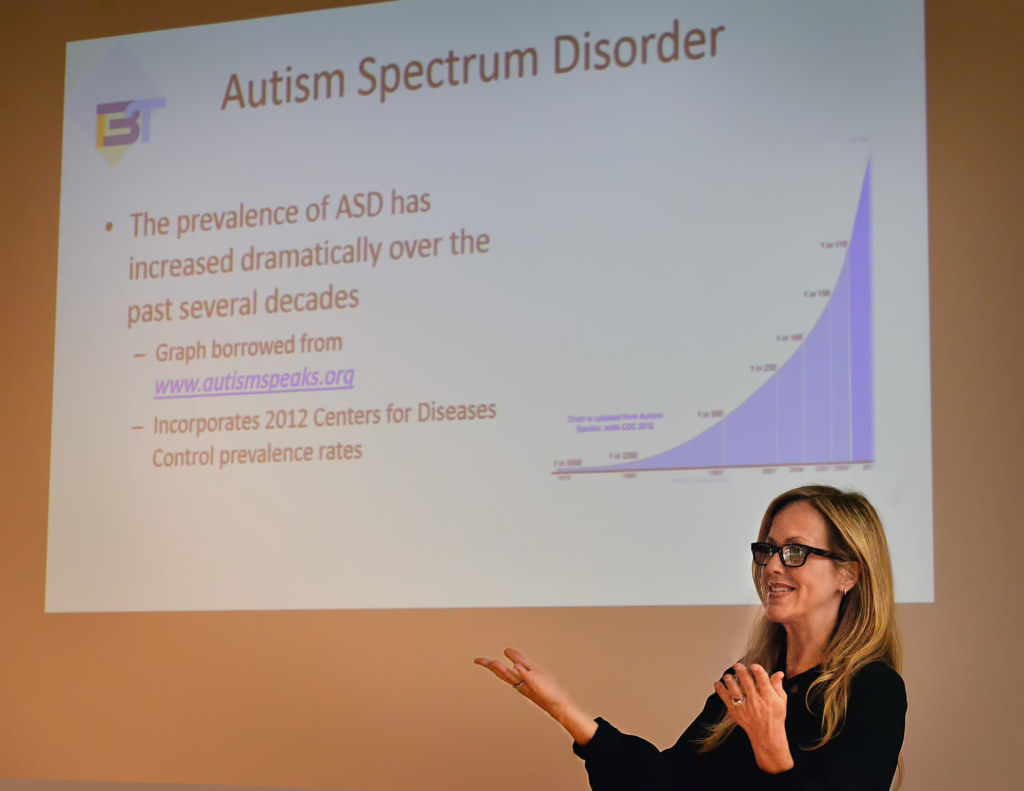Come over here and sit down.
What is your name?
Where do you live?
For most people, such commands and questions are simple.
For children and young adults on the autism spectrum, they can be problematic — especially when a police officer is issuing or asking them.
The person may not understand the role of a cop and become confused and intimidated.
The situation may be unfamiliar and therefore stressful to him or her — causing even more problems.
He or she just may not get it.
Experts on autism and its exploding prevalence recently made a presentation to members of the Garden Grove PD, whose officers, officials say, now routinely engage with teens and young adults on the autism spectrum.

Lisa Bancroft, supervisor at the Center for Autism and Related Disorders in San Juan Capistrano, teaches a class on “Recognizing and Responding to Autism in the Community – An Introduction for First Responders.” Photo by Steven Georges/Behind the Badge OC
As cops, they have one primary job: quickly assess a situation and determine if a crime has occurred, and take steps to insure public safety.
“Officers are trained to evaluate every piece of information on every call so they can effectively provide the highest degree of professional services,” said attendee John Reynolds, a sergeant with the GGPD’s Youth Services Unit, which includes four officers assigned to eight intermediate schools, six high schools and one continuation school.
But officers don’t have the luxury to spend the time it takes to make detailed mental health assessments on the spot, said Reynolds, who was among the few dozen attendees at the June 10 training seminar led by members of the Center for Autism Related Disorders in San Juan Capistrano.
CARD Supervisor Lisa Bancroft and her associate, Samantha Benedicto, spent more than an hour describing the prevalence and symptoms of those on the autism spectrum and offering tips to cops and other first responders on how to interact with them.
The Centers for Disease Control says around 1 in 68 American children is on the autism spectrum — a 10-fold increase in prevalence in 40 years, Bancroft said.

Keith Velotta, fire captain at Station 1 of the Garden Grove Fire Department, talks about his 9-year-old son, Nathan, who has autism.
Photo by Steven Georges/Behind the Badge OC
The causes of autism remain a topic of debate and it may be years for research to come up with answers. What’s not as much in debate is the increased prevalence of the disorder.
Kelly McKinnon-Bermingham, director of Behavior Intervention at The Center for Autism & Neurodevelopmental Disorders in Santa Ana, did not attend the GGPD seminar but she offered perspective on the critical need for first responders to be educated about the disorder.
“Families and first responders struggle to deal with the challenging behaviors that can be encountered when working with a child with autism, including noncompliance, hyperactivity, anxiety, aggressive and even self-injurious behaviors,” McKinnon-Bermingham said.
“Families desperate to keep their children safe in their home are struggling. Even keeping a child safe can be very difficult.”
According to the Journal of Pediatrics, 49 percent of parents reported their autistic child had wandered off or run away at least one time after the age of 4. Over half of these wandering went missing long enough to cause worry.

Lisa Bancroft, supervisor at the Center for Autism Related Disorders, makes a point. Behind her is Samantha Benedicto, left, case coordinator for CARD.
Photo by Steven Georges/Behind the Badge OC
“That study confirmed wandering creates great stress for families,” McKinnon-Bermingham said. “Half of the parents reporting indicated they have received no guidance to prevent or address wandering behavior. Preparing families and first responders to prevent, prepare for and respond appropriately to a wandering child is crucial.”
Autism is a neurodevelopment disorder that presents as a range and each person uniquely presents with a different set of symptoms, Bancroft told the GGPD personnel.
And the disorder often can’t be detected by physical appearance alone, she added.
Garden Grove Police Det. David Lopez, who is assigned to Reynolds’ unit, said he and his colleagues routinely encounter teens with autism whereas in the recent past such encounters would be relatively rare.
Det. Lopez recalled a recent incident during which a young adult was swinging around a hammer at a fence after he had trespassed on an elementary school. He was arrested without incident after police evaluated the young adult and determined his actions to be criminal.
Special Officer Andy Flaws, another YSU officer who works for Reynolds and who attended the seminar, recalled a case in which a teenage male with autism became fixated on a girl. School officials and police were able to intervene before the boy’s conduct rose to the level of being criminal, Flaws said.
Describing Autism Spectrum Disorder (ASD), Bancroft said the prevalence is four to five times higher in males than females and that the disorder cuts across all ethnicities.

Tuong Van Vu, a CERT volunteer for Garden Grove Police and Fire, attends an autism awareness training class at the Courtyard Center in Garden Grove.
Photo by Steven Georges/Behind the Badge OC
The brains of people with ASD “work on a different wavelength,” Bancroft said, adding: “They are very smart but can’t communicate with the mainstream.”
People with ASD typically have very limited speech and have limited comprehension of what others are saying. This is critical for police officers to understand, she and Benedicto stressed.
“Lack of communication doesn’t necessarily mean lack of cooperation or compliance,” Benedicto told the officers and a few members of the Garden Grove Fire Department, including Capt. Keith Velotta, whose 9-year-old son, Nathan, has been diagnosed with ASD.
Benedicto and Bancroft offered tips to officers when they encounter a person with autism:
— Slow down and simplify your language. “This is probably one of the most important things,” Bancroft said.
— Ask the person if they use an iPad or other device to communicate.
— Ask the person one question at a time.
— If possible, use gestures or pictures to communicate instructions. Some helpful phrases to use include “use your words, “tell me” and “I don’t understand.”
— Remember that many people with autism avoid eye contact and may have difficulty reading the emotions of others. They also may have difficulty regulating their own emotions. And they may not understand social norms or rules.

Betty Tia, clinical lead manager at the Center for Autism and Related Disorders, gives her input during audience feedback.
Photo by Steven Georges/Behind the Badge OC
— Many people with autism engage in repetitive and ritualistic behaviors. Some may be rigid and inflexible with their routines. And many have highly fixated interests such as talking about specific suspects.
“If, for example, you notice (the autistic person) is talking about cars, use that to gain compliance or trust,” Bancroft advised. “Tell that person, ‘Let’s talk about cars for a minute’ before moving on to what you want them to do, or have a person they are familiar with help you gain their compliance.”
— Be patient and have a calm demeanor.
— Many autistic people have difficulties with sensory input. Try to tone down sirens and lights and give the person lots of physical space.
— Identify yourself as an officer and tell the person you are there to help him or her.
— If a person with autism is taken into custody, try to calm the situation as much as possible.
Reynolds and his YSU officers work very closely with the Garden Grove Unified School District staff and their students.
When officers are called to handle a student issue and the student has autism, they work with GGUSD staff and counselors to thoroughly evaluate the need for police service, Reynolds said.
“Our officers have a very good working relationship with GGUSD staff and have demonstrated a very well-rounded approach when handing autistic students involved in calls requiring police services,” he said.
Added Reynolds: “The comprehensive training we received today provides additional training for our officers so they can work more effectively with autistic children in our schools and in our community.”
Reynolds and other officers at the seminar noted the need for a response team to be available for police calls involving a person with ASD.
Such a concept may not be too far off from evolving.
The Center for Autism & Neurodevelopmental Disorders recently was awarded a grant from the UniHealth Foundation that will allow McKinnon-Bermingham to work directly with Orange County first responders to identify the current needs and challenges, and to work in conjunction with them to develop systems and strategies for first responders and families.
“We look forward to working with all police personnel and first responders in Orange County,” McKinnon-Bermingham said.
 Behind the Badge
Behind the Badge




